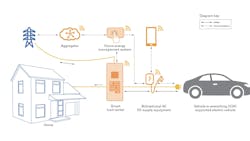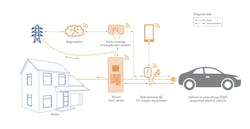EV Installations on the Home Front — Part 4 of 4
The energy transition continues to advance, and with it comes rising demand for electric vehicle (EV) infrastructure in single-family homes.
Throughout this article series, we’ve explored a multitude of important considerations for electrical professionals when it comes to installing EV infrastructure. First, we looked at the need to ensure energy capacity meets charging needs. Next, we examined safety as a paramount concern. Most recently, we looked at different charging configurations and the role they play in optimizing customers’ experiences with their EV purchases.
In this final installment, we’ll look at a topic that should be on every electrical professional’s mind: installing EV infrastructure amid the transformation of home energy systems.
Innovation on the horizon
Residential energy systems are undergoing major changes as EVs proliferate. The energy transition has given homeowners new opportunities to reduce their carbon footprints through electrification — from adding more electric appliances to achieving whole-home electrification.
Many homeowners are also embracing alternative approaches to powering the home — from the integration of more renewable energy (e.g., solar) and battery energy storage to full-scale residential and community microgrids. Managing this new electrical ecosystem requires special knowledge and consideration.
Each innovation presents an opportunity for contractors to design electrical systems that help homeowners become smarter and more efficient, sustainable users of energy. Therefore, when approaching EV charging installation projects, contractors should think about installation not simply as a solitary addition to a home but also as part of the broader transformation of home energy systems that will provide benefits for years to come.
Emerging trends
To understand the role of EV charging in the transformation of home energy systems, contractors need to become familiar with the innovations supporting this transformation and their impact on electrical loads in the home.
One such innovation is the growth of smart home energy management solutions, which encompass smart appliances and thermostats as well as components like smart wiring devices, circuit breakers, and load centers. These solutions, when integrated with smart home ecosystems and managed via integrated mobile apps, give homeowners greater control over their home energy usage and enable them to make smarter energy decisions. Many homeowners will want to include and manage home EV charging within this ecosystem, making it important for contractors to understand the technologies (both hardware and software) and standards that may impact it.
Another innovation is the integration of renewable energy and residential microgrids. More homeowners than ever are seeking to generate their own power through the deployment of solar and battery energy storage to offset energy costs and increase resiliency. Some are even implementing dedicated microgrids, which can help power the home when grid power is unavailable — an attractive solution in outage-prone regions.
In addition to their benefits during outages, microgrids can reduce energy costs by helping to effectively manage loads, which is especially critical for larger loads like EVs. It can also help homeowners take advantage of utility incentives for initiatives such as peak shaving and demand response.
One more innovation on the horizon is the opportunity to use the stored energy in EVs as a source of power rather than a load, providing energy back to different elements of the home. Some examples include:
- Vehicle-to-home (V2H): Leverages the vehicle’s battery to power essential needs in the home, especially when the grid is down.
- Vehicle-to-grid (V2G): Puts EVs to work by returning energy stored in batteries to the grid, especially during peak load times when the utility can use extra capacity.
- Vehicle-to-vehicle (V2V): Enables flexibility to recharge anywhere by plugging into another EV.
- Vehicle-to-everything (V2X): Uses stored power in vehicles to provide energy during an emergency or wherever the grid is remote or doesn’t exist.
Contractors should take steps to learn more about these approaches as more homeowners may seek to implement them in the years to come. They should consider enabling technologies, such as smart circuit breakers, that can help prepare homes for the transition to help future-proof investments.
Changing landscape for electric utilities
The landscape for electric utilities is evolving amid the transformation of home energy systems. EVs represent a significant power draw for the grid, and many electric utilities are taking creative approaches to manage this power draw in a way that ensures adequate power availability for charging and other needs. This can include the addition of programs like frequency regulation and demand response as well as new rate structures that might benefit both the electric utility and their customers.
Contractors should become familiar with the local electric utility’s special programs and rates as well as incentives available at the state and federal level that can help homeowners uncover opportunities to save costs and more effectively use energy when charging their EV. With more installations will come more knowledge, so contractors should make a checklist of rates and incentives to educate customers proactively and help maximize their investment and cost savings.
Future-proofing investments
While the adoption of technologies such as smart home energy management and renewables may be nascent, many homeowners will want to implement them shortly. This is why contractors must help future-proof customer investments, ask questions about their energy goals, and install solutions that will make it easier for them to integrate new solutions as their needs evolve. For example, installing a smart circuit breaker in the load center can enable the future ability to integrate smart home energy management technologies.
The advancing energy transition is causing important and welcome changes to both transportation and residential energy. Electrical professionals have an essential opportunity to become trusted advisors as they help customers assess EV deployments and consider future steps in their electrification journey. By understanding innovations on the horizon and the role EVs play as part of the broader ecosystem, electrical contractors can help prepare homeowners to become active participants in a more sustainable future.
About Eaton Experience Centers
At Eaton’s Experience Centers, visitors learn about industry best practices and the latest innovations through hands-on training in multiple application environments. The Eaton Experience Centers in Pittsburgh, PA and Houston, TX are full-scale demonstration and testing facilities where visitors can see firsthand the latest advances in electrical power quality, energy management and safety. In controlled environments, visitors observe product testing and performance, participate in live demonstrations and training courses, and learn about power management technologies from Eaton experts. The goal of Eaton’s Experience Centers is to help take the mystery out of electrical power systems spanning from utility substation equipment to the receptacles in the home. To learn more, visit Eaton.com/Experience.
About the Author
Dan Carnovale
Dan Carnovale is the director of the Eaton Experience Centers in Pittsburgh and Houston. He is a registered Professional Engineer in the states of Pennsylvania, California and Alaska, a Certified Energy Manager (CEM) and a Senior Member of IEEE. He can be reached at [email protected].

